

In Quantum Breakthrough, Scientists Get Two Photons To Interact. Two photons hanging out in free space want nothing to do with each other: Waves of light simply pass through each other without either one having an effect on the other.

Now, researchers have found a way to spark a strong interaction between two single photons by using an ultra tiny fiber of glass. The findings were published in Nature Photonics this week. For many applications in quantum technology, the interaction between photons is a crucial prerequisite: from transmitting information through tap-proof quantum channels to building light-transistors for quantum computing, maybe even quantum teleportation.
“In order to have light interact with light, one usually uses so-called nonlinear media,” says Arno Rauschenbeutel of TU Wien, the Vienna University of Technology. Light affects certain properties of these materials, which in turn influences the light, leading to an indirect coupling between photons. Images: TU Wien Read this next: How Notorious HIV Is Being Hijacked To Tackle Cancer. Quantum leap in lasers brightens future for quantum computing. Dartmouth scientists and their colleagues have devised a breakthrough laser that uses a single artificial atom to generate and emit particles of light.
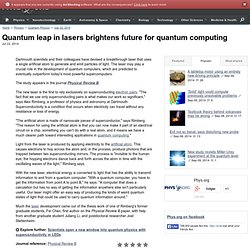
The laser may play a crucial role in the development of quantum computers, which are predicted to eventually outperform today's most powerful supercomputers. The study appears in the journal Physical Review B. The new laser is the first to rely exclusively on superconducting electron pairs. "The fact that we use only superconducting pairs is what makes our work so significant," says Alex Rimberg, a professor of physics and astronomy at Dartmouth. Superconductivity is a condition that occurs when electricity can travel without any resistance or loss of energy.
Alcubierre drive. Two-dimensional visualization of the Alcubierre drive, showing the opposing regions of expanding and contracting spacetime that displace the central region.
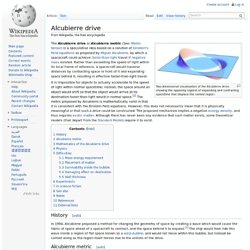
The Alcubierre drive or Alcubierre metric (See: Metric tensor ) is a speculative idea based on a solution of Einstein's field equations as proposed by Miguel Alcubierre , by which a spacecraft could achieve faster-than-light travel if negative mass existed. Rather than exceeding the speed of light within its local frame of reference, a spacecraft would traverse distances by contracting space in front of it and expanding space behind it, resulting in effective faster-than-light travel.
History [ edit ] Alcubierre metric [ edit ] Geodesics in general relativity. In general relativity, a geodesic generalizes the notion of a "straight line" to curved spacetime.
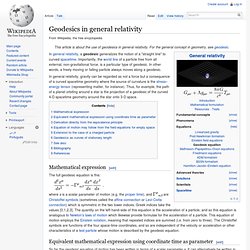
Importantly, the world line of a particle free from all external, non-gravitational force, is a particular type of geodesic. In other words, a freely moving or falling particle always moves along a geodesic. Energy condition. In relativistic classical field theories of gravitation , particularly general relativity , an energy condition is one of various alternative conditions which can be applied to the matter content of the theory, when it is either not possible or desirable to specify this content explicitly.
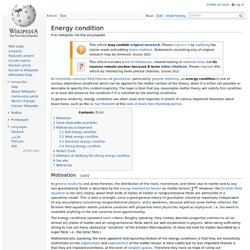
The hope is then that any reasonable matter theory will satisfy this condition or at least will preserve the condition if it is satisfied by the starting conditions. In general relativity, energy conditions are often used (and required) in proofs of various important theorems about black holes, such as the no hair theorem or the laws of black hole thermodynamics . Motivation [ edit ] In general relativity and allied theories, the distribution of the mass, momentum, and stress due to matter and to any non-gravitational fields is described by the energy-momentum tensor (or matter tensor ) . The energy conditions represent such criteria. Some observable quantities [ edit ]
Killing vector field. Length contraction. In physics, length contraction is the phenomenon of a decrease in length measured by an observer of objects which are traveling at any non-zero velocity relative to the observer.

This contraction (more formally called Lorentz contraction or Lorentz–FitzGerald contraction after Hendrik Lorentz and George FitzGerald) is usually only noticeable at a substantial fraction of the speed of light. Length contraction is only in the direction parallel to the direction in which the observed body is travelling. This effect is negligible at everyday speeds, and can be ignored for all regular purposes. Only at greater speeds does it become relevant. At a speed of 13,400,000 m/s (30 million mph, 0.0447c), the contracted length is 99.9% of the length at rest; at a speed of 42,300,000 m/s (95 million mph, 0.141c), the length is still 99%. Where. Lorentz transformation. In physics, the Lorentz transformation (or transformations) is named after the Dutch physicist Hendrik Lorentz.

It was the result of attempts by Lorentz and others to explain how the speed of light was observed to be independent of the reference frame, and to understand the symmetries of the laws of electromagnetism. The Lorentz transformation is in accordance with special relativity, but was derived before special relativity. The transformations describe how measurements of space and time by two observers are related. They reflect the fact that observers moving at different velocities may measure different distances, elapsed times, and even different orderings of events. Minkowski space. In theoretical physics, Minkowski space is often contrasted with Euclidean space.
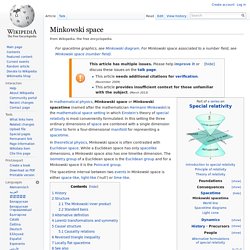
While a Euclidean space has only spacelike dimensions, a Minkowski space also has one timelike dimension. The isometry group of a Euclidean space is the Euclidean group and for a Minkowski space it is the Poincaré group. History[edit] In 1905 (published 1906) it was noted by Henri Poincaré that, by taking time to be the imaginary part of the fourth spacetime coordinate √−1 ct, a Lorentz transformation can be regarded as a rotation of coordinates in a four-dimensional Euclidean space with three real coordinates representing space, and one imaginary coordinate, representing time, as the fourth dimension. The views of space and time which I wish to lay before you have sprung from the soil of experimental physics, and therein lies their strength. For further historical information see references Galison (1979), Corry (1997), Walter (1999).
Structure[edit] The Minkowski inner product[edit] Standard basis[edit] where.